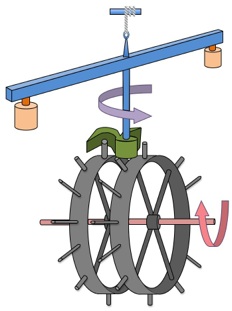Clocks

1. Ancient Time Mechanisms
Disclaimer
Whilst some care has been taken to check externally linked websites no responsibility is offered nor implied for the suitability, legality or reliability of content therein.
Introduction
To some people looking at, owning, let alone building, a clock might seem the most boring subject in the world. Planes, trains, cranes and automobiles have a certain obvious caché when it comes to subjects that we are familiar with. Yet my experience of people’s reaction at exhibitions is quite different. Not everyone rushes across a room to gaup at a stupid ticker just sitting there making an intermittent click but I’m constantly surprised by people’s fascination with mechanisms that move and even better: move with a purpose. Clocks are just such a subject. A simple AC synchronous motor driving a number of hands on a dial might seem rather boring but it needn’t be if it’s a Krazy Clock with entertaining whirly parts (see right).
And not only entertaining but along with printing and weaving our forebear’s development of timekeeping is inextricably connected with their development of technology. Let’s look at the variety of clocks that have existed down the years..

2. Old Clock Escapements
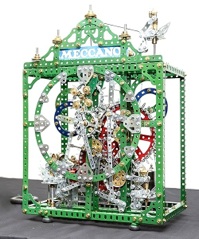
Keith Cameron’s Krazy Clock
(built by Bob Palmer)
This page has been developed to identify types of clock that are, or could
become, subjects for model making. Often in the best medium in the world, Meccano, but not exclusively so.
The Antikythera Mechanism
There is one other machine that is linked to time that deserves a mention. It’s not a clock but an eclipse predictor. From a shipwreck by the island of Antikythera in Greece in 1901 a lump of rusty metal was pulled to the surface that would change our entire modern day perspective of who understood what technology at what time in human history. Sadly the bronze and other metals had seriously corroded but the shipwreck was accurately known to have sunk around 70-60 BC so the mechanism certainly predated that.

This following short film by Philippe Nicolet gives a simplified introduction to the astounding knowledge of lunar phases and eclipses, the sun’s 19 year cycles, trivia like which cities were due to hold which Olympic Games next and even the paths of Mercury, Venus, Mars Jupiter and Saturn across the night sky eg venus. However the wikipedia page is far more informative (see right).
Thankfully the discoverer and subsequent historians sought not to split the lump into pieces and destroy what could later be discovered by modern radiological methods. Instead it has been treated carefully and its 37 gear wheels and various setting dials have been slowly deciphered. It is easy to dress this hand-driven machine up in cliches but suffice to say that nobody even started on the road to such sophistication until at least 14 centuries later.

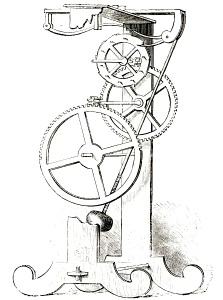
Water Clocks
It’s obvious that in arranging to meet, engage in rituals or hunt together our earliest ancestors must have used the position of the sun in the sky to coordinate their actions. But how would they do that if the sun was obscured by cloud for long periods of time in Winter for instance ? Some Indian and Chinese historians claim that their ancestors used a method of measuring water flowing from a hole in a vessel some 4000 years ago. Evidence shows that this was later employed by the Babylonians, Egyptians and then Ancient Greeks.
Escapements
As we’ve seen a clock generally consists of a method of storing energy that is supplied to a system that reliably allows that energy to escape in a regulated way. Rather than water it was realised that a better system had to be mechanical. At the heart of any mechanical clock this is known as the escapement and so it is these that will become the focus of the examples given on the remainder of this page.
Knowledge Loss
It’s not surprising that given man’s interest in the movement of the heavenly bodies he wanted to predict their movement -Stonehenge and later the pyramids were built partly to achieve that. Nowadays we have discovered that the Greeks were way ahead of the mechanical prediction game with their Antikythera Mechanism (see below). However when the Romans ousted them this knowledge was lost until 1901 so all development halted throughout the Dark Ages.
John Of Wallingford
In 1322 in Norwich and 1325 in St Albans timekeeping suddenly sprang to the fore. In the abbey of the latter blacksmith John Of Wallingford connected one of the earliest types of astrolabe, a planetary diagram, to a time counting device suddenly kicking off modern mechanical technology. Around the same time similar devices may have been devised in Italy but John’s was well documented in his Tractatus Horologii Astronomici. A beautiful copy was built in 1979 and still runs ! (See thorough and well researched Nicholas White Weblog Notes but he warns against buying John North’s rambling book on the subject -see onward link).
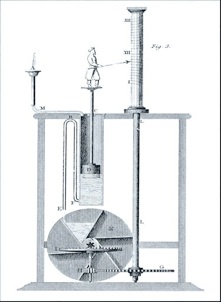
Water Thief by Ctesibius
(artist’s impression)

Swinging Weights
Galileo
Deduced Antikythera Gearing
(with link to Wikipedia)

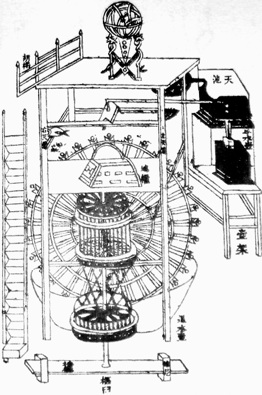
Obviously all technology is a development of previous experience. Naturally development can come in leaps and bounds. Pythagorus is famously placed early in the chain. Another such leaping person was a mathematician and inventor in Greek occupied Alexandria in Egypt. Ctesibius researched the movement and compression of liquids and air by pistons in cylinders and of closure of pathways by valves. As a result he became known as The Father Of Pneumatics. Had he noticed that enclosed boiling water developed pressure who knows when the Industrial Revolution may have started. Amongst many things he devised the Water Thieve, a form of timekeeper, in 250BC (see left).
Perhaps Ctesibius rigorous research methods were what the beginnings of modern technology as we now know it needed ? His ideas must certainly have influenced Archimedes, Hipparchus, Gallileo, Newton etc. As ground breaking as this was fluid flow systems were never going to be accurate and can hardly be counted as portable.
Update
A more up to date treatise is now linked on my subpage: Fascinating Science
Gigantic Water Clock
(from Chinese manuscript)
Astrolabe by God’s Clockmaker John Of Wallingford
(St Albans Abbey)
Verge Escapement
The pendulum had not yet been invented by Galileo but the use of swinging weights had been toyed with for some time. John’s escapement, looking like rabbit’s ears (shown green above), was driven by a large falling weight (not shown) causing two wheels, each with pins around the periphery to alternately catch on one ear then the other. A form of early folio. This was the pinnacle of innovation for 100years. He used relatively heavy bob weights (shown in brass) and cut down friction by suspending these on a pivoting arm itself suspended by a thin steel chord. To see this working click the picture.

